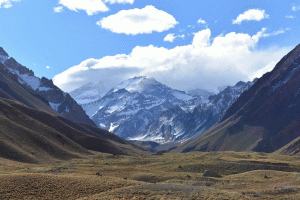Climbing Aconcagua and Weather Patterns
By Michael FaginClimbing Aconcagua
Climbing Aconcagua, “the Colossus of America,” means conquering the tallest mountain in South America. Along the Andes – the world’s longest stretch of mountains – East of Santiago, Chile, just over the Argentinian border in Mendoza Province, “The Sentinel of Stone” stands. Aconcagua is derived from the native Aymaran words “kon” and “kawa,” which translate to “snow” and mount,” respectively. High up, it’s cold enough to maintain a snowpack all year round, despite air masses from South America’s heat-capturing rainforests lending to substantial regional instability. The peak’s prestige and local dominance arose from volcanic activity just ten million years ago
Aconcagua’s Weather
While northerners in the Northern Hemisphere bundle up in the bitter cold in January and February, the weather they associate with July and August is experienced in South America. It’s not the only thing that may seem backwards. The Coriolis effect spins unstable storm systems counterclockwise – a motion indicative in the Northern Hemisphere of an absence of storms.
Storms on Aconcagua are fueled by warm, moist sea air from the Pacific anticyclone encountering the cold, dry air in the Chilean and Argentinian mountains. The altitudes of the mountains to the west tend to lead to the evaporation of much of the oceanic moisture that may head eastward. In the summer, that often generates lightning strikes accompanied by no rain or high-altitude light snow. Due to the typical shape of the region’s weather patterns, lightning strikes are a threat especially over the mountain’s northwestern quadrant.
Little departs from normality during northwestern Argentina’s wintertime La Niña. Cooler ocean temperatures to the northwest are typical but they yield a nearly neutral net effect at Aconcagua. If anything, the oceanic moisture is cooler and contrasts less with the high altitudes inland, which discourages precipitation and lightning.
In contrast to the coastal Peruvian El Niño hundreds of miles north, the Aconcaguan El Niño is much less consequential in the winter. Spring to summer can be warmer and wetter. Presently, models are suggesting El Niño will both return and stick around this Spring.
Climbing Aconcagua Winter 2019
What will winter 2019 bring for Aconcagua? The ECMWF is calculating an above normal temperature anomaly, slowly diminishing heading toward March. The height of the 500 mb atmospheric pressure level, forecast to be higher than normal, trends to foretell fewer storms and less snowfall. The pressure level is expected to remain relatively high until the second week of February.
The IRI models are foretelling a similar change in early February from the present weather trends: nearly typical seasonal temperatures and precipitation are expected heading into Spring. Near Aconcagua, around 19,300’ below summit, February typically brings temperatures in the low-70Fs with only about 1.5’’ of water equivalent precipitation.
Written by Meteorologist Geoff Linsley
